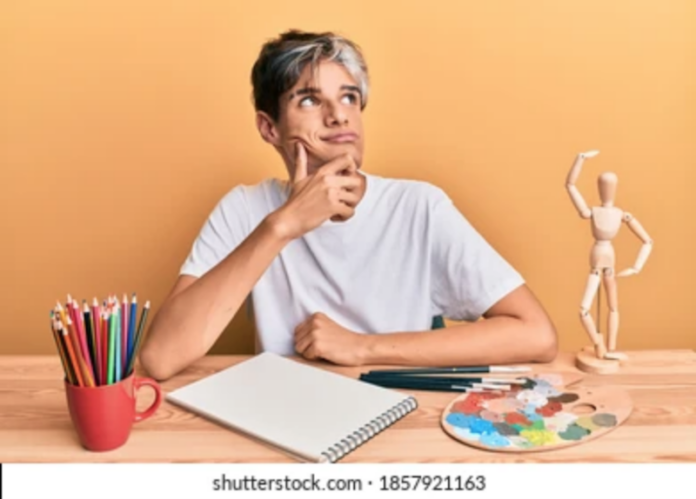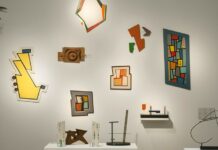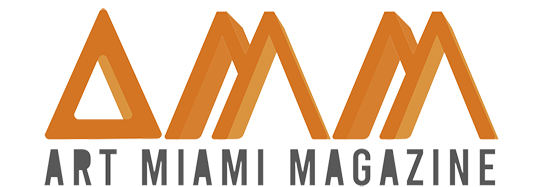Questions to ask yourself & sample answers when writing an artist statement:
The mission of Art Miami Magazine is to provide artists with opportunities to grow and advance in their artistic careers. We understand the importance of artist statements in conveying your artistic vision and connecting with your audience. While the following are sample answers, we encourage you to personalize your responses to reflect your unique artistic voice and experiences.
Why Do You Make This Type of Art?
a) I am drawn to this type of art because it allows me to express my emotions and ideas visually captivatingly and evocatively. It provides me with a unique means of communication and a way to connect with others on a deeper level.
b) I make this type of art because I am drawn to the beauty and mystery of the natural world. I enjoy using my art to capture nature’s essence in a realistic and expressive way.
What Does Your Artwork Represent?
a) My artwork represents a fusion of personal experiences, observations, and reflections on various aspects of life. It explores themes of identity, the human condition, and the interconnectedness of individuals and the world around us.
b) My artwork represents my interpretation of the natural world. I hope my work can help people see nature’s beauty and wonder in a new way.
What Inspires You?
a) I find inspiration in the beauty of nature, the intricacies of human relationships, and the power of emotions. Additionally, literature, music, and the works of other artists ignite my creativity and push me to explore new artistic possibilities.
b) Many things, including nature, music, literature, and other artists inspire me. I am also inspired by the people in my life, who have taught me so much about love, loss, and the human experience.
How Do You Make It?
a) I create my artwork through a combination of traditional and contemporary techniques. I experiment with different mediums, such as acrylics, oils, and mixed media, to achieve the desired textures, colors, and effects that bring my vision to life.
b) I make my artwork using various techniques, including painting, drawing, and sculpture. I often use traditional media, such as oil paint and pencil, but I enjoy experimenting with digital art.
What Does Your Art Mean to You?
a) My art is a form of self-expression and a way for me to make sense of the world. It serves as a cathartic outlet, allowing me to process emotions, explore complex ideas, and share my perspectives with others. It is profoundly personal and holds significant meaning for me.
b) My art means a lot to me. It is a way for me to express myself creatively and share my love of the natural world. I hope that my work can bring joy and inspiration to others.
Describe your materials and working process in detail, including the scale and size of your work.
a) I primarily work with acrylic paints on canvas, utilizing brushes, palette knives, and various mark-making tools. The scale and size of my work vary, ranging from intimate pieces that invite close examination to larger-scale works that create a more immersive experience for viewers.
b) I use various materials, including oil paint, pencil, charcoal, and acrylic paint. I often work on large-scale canvases, but I also enjoy working on smaller, more intimate pieces. My working process is usually iterative, with me making changes and adjustments to my work as I go along. I often work from photographs, but I also enjoy working from life.
Why have you chosen the medium/media that you use?
a) I have chosen acrylic paints for their versatility, quick drying time, and ability to layer and build texture. The medium allows me to work with bold colors, create depth, and experiment with different techniques that enhance the visual impact of my artwork.
b) I have chosen the medium/media that I use because they allow me to express myself creatively in a personal and expressive way. I enjoy the challenge of working with different materials and techniques, and I find that each medium has its own unique qualities that can be used to create different effects.
What formal aspects of art are of primary interest to you?
a) The interplay of light and shadow, composition, and color are of primary interest to me. I am intrigued by how these formal elements can evoke emotions, create depth, and guide the viewer’s gaze within a piece.
b) The formal aspects of art that are of primary interest to me include composition, color, line, and form. I am interested in how these elements can be used to create a sense of balance, harmony, and movement in my work.
Describe any themes, motifs, symbols, references, or images that recur in your work. What is their significance to you?
a) One of the themes that recurs in my work is the relationship between humans and nature. I am interested in exploring how humans interact with and impact the natural world. I also explore themes of love, loss, and the human condition in my work.
b) In my work, you will often find recurring themes of transformation, balance, and the duality of human nature. Symbols such as birds, trees, and water frequently appear, representing freedom, growth, and fluidity. These motifs serve as visual metaphors for deeper concepts and personal experiences.
Are there particular aspects of your biography or your life experience that would help a viewer appreciate your work?
a) I grew up in a small town surrounded by nature. I have always been drawn to the beauty of the natural world, and I believe this has profoundly impacted my work. I have also experienced loss and hardship in my life, and these experiences have also informed my work.
b) My multicultural background and experiences of living in different countries have shaped my perspective and enriched my artistic vision. The blending of cultures, diverse landscapes, and encounters with various traditions have influenced the themes and narratives explored in my artwork.
How do you hope a viewer will respond to your work?
a) I hope that viewers will respond to my work with a sense of wonder and awe. My work will inspire them to appreciate the natural world’s beauty and reflect on their own place in the world.
b) I want viewers to engage with my artwork on an emotional and intellectual level. I want them to connect with the themes and ideas conveyed, to be moved, inspired, or challenged in their own thoughts and perceptions. Ultimately, I aim to provoke introspection and invite personal interpretations.
List 3 to 5 adjectives that you feel are relevant to your work; then, list 3 to 5 adjectives, descriptions, or terms that are inaccurate, overused, or that you don’t like.
Adjectives that are relevant to my work:
a) Beautiful
Expressive
Emotional
Thought-provoking
Realistic
Adjectives, descriptions, or terms that are inaccurate, overused, or that I don’t like:
Obscure
Cerebral
Pretentious
Dry
Technical
b) Relevant adjectives for my work:
Evocative
Intricate
Thought-provoking
Dynamic
Expressive
Inaccurate, overused, or disliked adjectives for my work:
Generic
Predictable
Clichéd
Simplistic
Conventional
What might surprise someone about your work?
a) Some people might be surprised by the emotional depth of my work. I often deal with heavy topics in my work, but I always try to do so in a way that is both beautiful and accessible.
b) What might surprise someone about my work is the hidden layers of symbolism and meaning woven into each piece. Upon closer examination, viewers may discover subtle details or narratives that invite deeper exploration and engagement.
What are some of the most common questions people ask about your work?
a) How long does it take you to create a piece of art?
The time it takes me to create a piece of art varies depending on the size and complexity of the piece. I usually spend several weeks or even months working on a single piece.
a1) What is your favorite medium to work with?
I don’t have a favorite medium, but I enjoy working with various materials, including oil paint, pencil, charcoal, and acrylic paint.
a2) Where do you get your inspiration?
I get my inspiration from many sources, including nature, music, literature, and other artists. I am also inspired by the people in my life who have taught me so much about love, loss, and the human experience.
a3) What is the meaning behind your work?
The meaning behind my work is up to the viewer to decide. I hope my work can spark a conversation about the beauty and mystery of the natural world, the relationships between humans and nature, and the human condition.
a4) What advice would you give to aspiring artists?
My advice to aspiring artists is to be patient, persistent, and genuine to themselves. Developing your unique artistic voice takes time and effort, but it is worth it. Do not be afraid to experiment with different mediums and techniques; do not be afraid to fail. Failure is a part of the learning process. Most importantly, keep creating!
b) Some of the most common questions people ask about my work include inquiries about the inspiration behind specific pieces, the techniques and materials employed, and the intended emotions or messages conveyed. Viewers also often inquire about the stories or narratives behind certain motifs or symbols.
b1) How has your work changed over time? How do you anticipate becoming an artist in the next five years? Over time, my work has evolved in terms of technique, subject matter, and conceptual depth. I have embraced experimentation, honed my skills, and explored new avenues of artistic expression. I anticipate further growth by pushing boundaries, taking risks, and delving into more ambitious projects that challenge my technical abilities and conceptual framework. I aspire to continue refining my artistic voice, expanding my creative horizons, and engaging with a broader audience.
Why do you like to make art?
a) I like to make art because it allows me to express myself creatively. I enjoy the process of coming up with ideas, finding the right materials, and creating something that is both beautiful and meaningful to me. Art is also a way for me to connect with others and share my experiences with the world.
b) I am captivated by the power of art to communicate emotions, tell stories, and provoke thought. Creating art allows me to express myself in ways that words cannot, bringing me immense joy and fulfillment.
c) I am drawn to the creative process of art-making as a form of self-expression and exploration. It allows me to convey emotions, ideas, and perspectives in a visual language beyond words.
What subjects do you prefer? Why?
a) I am drawn to exploring the human condition and the complexities of human emotions. Through my artwork, I seek to capture moments of vulnerability, resilience, and connection, inviting viewers to reflect on their own experiences and perceptions.
b) I prefer to work with figurative subjects like people, animals, and landscapes. These subjects are more relatable to me and my work’s viewers. I also enjoy the challenge of capturing a subject’s essence in a realistic and expressive way.
c) I gravitate towards nature and landscapes as my preferred subjects. The beauty and harmony of the natural world inspire me, and I aim to capture its essence and evoke a sense of awe and connection in viewers.
What processes and techniques do you use? Why?
a) I employ mixed media techniques, including layering, texture creation, and experimental approaches. These techniques allow me to experiment and push the boundaries of traditional artistic practices, enabling me to create unique and dynamic artworks.
b) I use a variety of processes and techniques in my work, depending on the subject matter and my desired outcome. I often use traditional media, such as pencil, charcoal, and paint, but I enjoy experimenting with digital art. Being versatile and open to new ways of creating art is essential.
c) I embrace a mixed-media approach that combines traditional techniques with experimental processes. This allows me to push the boundaries of my creativity, fostering a sense of spontaneity and exploration in my artwork.
How is your work different from others?
a) My work stands out by emphasizing intricate details and the interplay of light and shadow. I strive to create a sense of depth and atmosphere that immerses viewers in the world I’ve created, offering them a unique perspective and inviting them to explore their own interpretations.
b) My work stands out by incorporating vibrant colors, intricate details, and a balance between realism and abstraction. I strive to create visually striking compositions that invite viewers to delve into the intricacies of the artwork and discover their own interpretations.
c) My work stands out by emphasizing intricate details and the interplay of light and shadow. I strive to create a sense of depth and atmosphere that immerses viewers in the world I’ve created, offering them a unique perspective and inviting them to explore their own interpretations.
What do you see in your artwork?
a) In my artwork, I see a reflection of my inner thoughts, emotions, and observations of the world around me. It serves as a visual diary, capturing the essence of moments, experiences, and the essence of the human spirit.
b) I see a reflection of myself and my experiences in my artwork. I also see the beauty and wonder of the world around me. My work inspires others to see the world in a new way.
c) In my artwork, I see a reflection of my inner world, emotions, and experiences. It is a visual representation of my thoughts and a means of exploring and understanding the complexities of human existence.
What are your goals and aspirations as an artist?
a) My goals as an artist are to continue honing my craft, expanding my artistic horizons, and engaging with a broader audience. I aspire to create meaningful connections through my art, inspire dialogue, and positively impact individuals and communities.
b) My goals as an artist are to continue growing and evolving in my artistic practice, to engage with a broader audience, and to have my artwork inspire and resonate with viewers. I aspire to create a body of work that reflects my artistic journey and leaves a lasting impact on those who experience it.
c) My goals and aspirations as an artist are to continue to grow and develop as an artist, share my work with others, and positively impact the world. Art has the power to change the world, and I hope that my work can play a small role in making the world a better place.
Answering these questions can help you better understand your artistic process and communicate your goals and vision to others. When writing your artist statement, be sure to be honest and authentic. Your statement should be a reflection of your unique perspective and voice.
Remember, these are just sample answers, and it’s essential to provide your own authentic responses that reflect your unique artistic voice and experiences.
Cover photo: Shutterstock.com #1857921163













